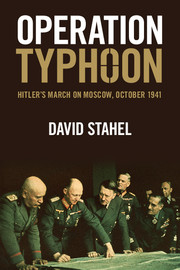Book contents
- Frontmatter
- Contents
- List of illustrations
- List of maps
- List of tables
- Acknowledgements
- Glossary
- Tables of military ranks and army structures
- Introduction
- 1 Contextualising Barbarossa
- 2 Operation Typhoon
- 3 Viaz'ma and Briansk
- 4 Carnage on the road to Moscow
- 5 Bock's final triumph
- 6 Exploiting the breach
- 7 Weathering the storm
- 8 Running on empty
- 9 The eye of the storm
- Conclusion
- Notes
- Bibliography
- Index
6 - Exploiting the breach
Published online by Cambridge University Press: 05 March 2013
- Frontmatter
- Contents
- List of illustrations
- List of maps
- List of tables
- Acknowledgements
- Glossary
- Tables of military ranks and army structures
- Introduction
- 1 Contextualising Barbarossa
- 2 Operation Typhoon
- 3 Viaz'ma and Briansk
- 4 Carnage on the road to Moscow
- 5 Bock's final triumph
- 6 Exploiting the breach
- 7 Weathering the storm
- 8 Running on empty
- 9 The eye of the storm
- Conclusion
- Notes
- Bibliography
- Index
Summary
Into the Bear's cave – Bock's drive on Moscow
While the battle at Viaz'ma was an undeniable success for Bock, his real objective in Operation Typhoon was to strike down Soviet power by taking Moscow. To the German command, this had now come tantalisingly close to fruition. The defending forces of the Red Army had been largely destroyed at Viaz'ma, and the remaining distance to the Soviet capital was less than the distances previously covered by earlier offensives at Minsk and Smolensk. Moscow's fall seemed almost preordained, but events on the ground suggested a far more troubling forecast of the next stage of the German offensive.
In the defensive battles on the eastern edge of the Viaz'ma pocket, the motorised forces of General of Panzer Troops Georg Stumme's XXXX Panzer Corps and Vietinghoff's XXXXVI Panzer Corps had played largely static roles. Under strict instructions from Kluge at Fourth Army, Hoepner had to maintain a tight perimeter, which aimed at preventing large-scale breakouts, but also prevented Panzer Group 4 from sending more forces in the direction of Moscow. Hoepner fumed at Kluge's short-sightedness in spite of the fact that even his heavy concentrations of motorised forces at Viaz'ma had trouble containing the trapped Soviet armies. Irrespective of such difficulties, Hoepner later complained: ‘The speed of the thrust to Moscow was reduced by the mistakes of the higher command.’ Hoepner could only send Kuntzen's LVII Panzer Corps towards Kaluga on 7 October and Obergruppenführer Paul Hausser's ‘Das Reich’ (belonging to Stumme's XXXX Panzer Corps) towards Gzhatsk. Kuntzen's panzer corps initially consisted of only one panzer division (the 20th) and this was down to just thirty-nine serviceable tanks by 11 October. Hausser's ‘Das Reich’ suffered even more heavily. In a flanking attack by Soviet tanks on 10 October the division suffered 500 losses, while on 14 October Hausser himself was seriously wounded by a grenade splinter (losing his right eye). The sodden ground also plagued the attack, with the 20th Panzer Division's war diary describing the smaller roads leading off the highway as ‘catastrophic’ and reporting the loss of many vehicles. On 14 October the Fourth Army reported to Army Group Centre that ‘movement by motorised vehicles off the roads is impossible’. At the same time it reported that ‘Das Reich’ had to continue its attack ‘on foot’ because the vehicles could no longer move forwards.
- Type
- Chapter
- Information
- Operation TyphoonHitler's March on Moscow, October 1941, pp. 173 - 208Publisher: Cambridge University PressPrint publication year: 2013



